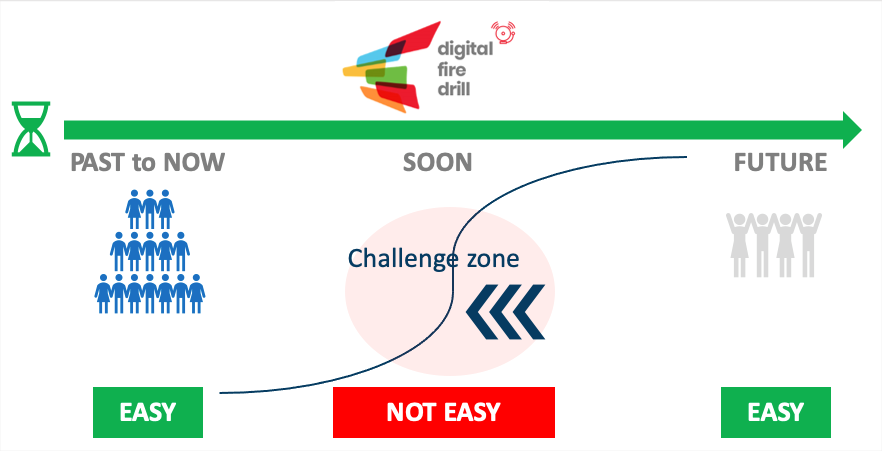Does an Employee hold a Position or does a Position hold an Employee?
Welcome to Corporate HR’s chicken-and-egg conundrum. On the surface, it may seem like a trivial issue; dig a little and you’ll find that taking one or the other perspective has significant implications for staffing models and planning processes.
For those unclear about the challenge, I shall thank the UK Civil Service for this informative presentation: Global HR Design: Organisation and Position Management.
According to its last slide, the Position Model is particularly suited to the “Controlled” organisation type, i.e.: “An organisation that is highly structured in which all aspects of work and remuneration are well organised and regulated”.
In the real world, however, the HR and Finance processes of this type of “Controlled” organisation (e.g.: global financial / service companies) will often use Headcount rather than Position Management.
Why?
Headcount vs Position: 1x vs 2x
While probably everyone will agree with the theory around Position Management, Headcount Management has a concrete immediacy that, especially with older-generation processes and technology solutions, can be easier to manage:
- “I need five headcount next month” is more straightforward than saying “my 100-person department has suffered two resignations, one more is likely to happen soon and two people are needed to satisfy the growth target as a result of initiative X”;
- in terms of record-keeping, Headcount Management means that, at any point in time, you will have ONE record for each resource in the company; Position Management, instead, will have TWO: one representing the active position, the other representing the person currently assigned to that position;
- the same “duality” applies to planning and hiring: Headcount Management says ‘hire this person’; Position Management says ‘I have created a new position, please hire someone into it’.
In other words, Position Management requires more sophisticated technology and processes.
Is it worth it?
Position vs Headcount: 0.5 effort
There are two key requirements for Position Management: that your HR technology supports it; that Planning (Finance, Resource Management) and HR are best buddies.
The second point deserves a little clarification: in Headcount Management, the interaction of Planning with HR would typically involve requesting hiring/terminations when needed, together with periodic meetings to review high-level trends; in Position Management, Planning operatives would have direct access to a “Position Planning Module” (part of the HR system), a level of ownership that forces a much closer collaboration.
Technology-enabled collaboration, when it works, means that you no longer need to reconcile; so, the prize for giving up some functional independence is that time-and-error-saving synergies instantly emerge.
The most obvious and probably the most substantial operational gain of Position Management is in the automated handling of replacements when people depart and leave a vacant position – primarily as a result of attrition, secondarily because of internal transfers.
Some numbers
Think of a 20,000-person organisation with 10% attrition and, say, a budget to support a growth rate of 8% over the course of one year: that’s 2,000 headcount leaving, 2,000 replacement hires and 800 growth hires.
In a Headcount Management model, 4,000 out of these 4,800 “resource planning events” to be tracked and reconciled with HR are to do with Attrition and Replacement.
Not so with Position Management: when someone leaves and their departure is recorded by HR, the now emptied Position record will automatically trigger a “replacement requisition”, eliminating the labour and the noise associated with regularly adjusting your plans for attrition.
The LiveDataset perspective
We have seen how the benefits of Position Management are realised through a coming together of processes and of HR/Finance technology.
While it is easy to picture a centralised HR system with its key functions, the thought of financial planning and forecasting will conjure up – for most corporate executives – the image of a spreadsheet…
…Or, more precisely, many spreadsheets (from as many departments / locations) which are periodically consolidated and fed into a central Finance system.
Turning spreadsheet nightmares into dream systems is one of LiveDataset’s core strengths, making a difference in areas such as Planning, Compliance, Governance, where data collaboration needs require flexibility and speed.
Working for many years with the Finance function of a 50,000-strong organisation, we had the chance to help with two significant transformations: one, at the very beginning, away from spreadsheets towards a tailored Headcount and Expense re-forecasting solution; a second one, over the last few months, to rapidly respond to a HR-led opportunity to leverage Position Management.
It is in the context of this second challenge that we got a direct appreciation for the Headcount vs Position Management conundrum: what started as a process upgrade, which we were ready to meet with our new “Flow” architecture, soon revealed several opportunities to short-circuit a number of processes and reconciliations that were previously necessary (mostly in the “challenge zone” highlighted in the diagram on the header).
At a time when many Corporate HR departments are considering the merits of Position Management – a module now offered by many platforms – it is clear that the technology and process challenges lie more on the Finance/Planning side, all too often in need of a first-order transformation away from spreadsheets.
The good news is… we can help!


